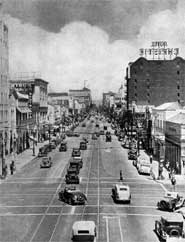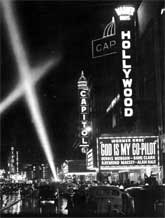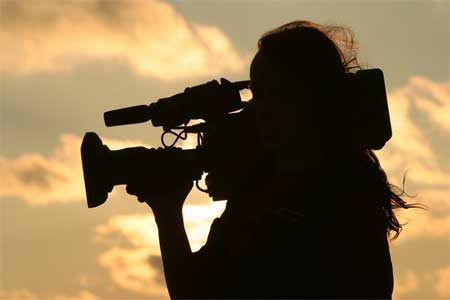Hollywood is a district of the city of Los Angeles, California, U.S.A. The population of the district is estimated at about 300,000 people. Due to its fame and identity as a major center of movie studios and stars, the word "Hollywood" is often used colloquially to refer to the American motion picture industry, a term deriving from the famous community. However, today many entertainment industry companies are presently based in nearby Burbank.

 In the early 1900s, motion picture production companies from New York and New Jersey started moving to California because of the reliable weather and longer days. Although electric lights existed at that time, none were powerful enough to adequately expose film; the best source of illumination for movie production was natural sunlight. Besides the moderate, dry climate, they were also drawn to the state because of its open spaces and wide variety of natural scenery. In the early 1900s, motion picture production companies from New York and New Jersey started moving to California because of the reliable weather and longer days. Although electric lights existed at that time, none were powerful enough to adequately expose film; the best source of illumination for movie production was natural sunlight. Besides the moderate, dry climate, they were also drawn to the state because of its open spaces and wide variety of natural scenery.
The first movie studio in the Hollywood area, Nestor Studios, was founded in 1911 by Al Christie for David Horsley in an old building on the southeast corner of Sunset Boulevard and Gower Street. In the same year, another fifteen Independents settled in Hollywood. Creators of dreams began arriving by the thousands; cameras cranked away, capturing images of custard pies, bathing beauties, comedy and tragedy, villains leering, heroines with long curls and heroes to save the day; and they built a new world to replace the lemon groves.
 The famous Hollywood sign originally read "Hollywoodland." It was erected in 1923 to advertise a new housing development in the hills above Hollywood. For several years the sign was left to deteriorate. In 1949, the Hollywood Chamber of Commerce stepped in and offered to remove the last four letters and repair the rest. The sign, located near the top of Mount Lee, is now a registered trademark and cannot be used without the permission of the Hollywood Chamber of Commerce, which also manages the venerable Walk of Fame. The famous Hollywood sign originally read "Hollywoodland." It was erected in 1923 to advertise a new housing development in the hills above Hollywood. For several years the sign was left to deteriorate. In 1949, the Hollywood Chamber of Commerce stepped in and offered to remove the last four letters and repair the rest. The sign, located near the top of Mount Lee, is now a registered trademark and cannot be used without the permission of the Hollywood Chamber of Commerce, which also manages the venerable Walk of Fame.
The first Academy Awards presentation ceremony took place on May 16, 1929 during a banquet held in the Blossom Room of the Hollywood Roosevelt Hotel on Hollywood Boulevard. Tickets were USD $10.00 and there were 250 people in attendance.

From about 1930, five major "Hollywood" movie studios from all over the Los Angeles area, Paramount, RKO, 20th Century Fox, Metro-Goldwyn-Mayer and Warner Bros., owned large, grand theaters throughout the country for the exhibition of their movies. The period between the years 1927 (the effective end of the silent era) to 1948 is considered the age of the "Hollywood studio system", or, in a more common term, the Golden Age of Hollywood. In a landmark 1948 court decision, the Supreme Court ruled that movie studios could not own theaters and play only the movies of their studio and movie stars, thus an era of Hollywood history had unofficially ended. By the mid-1950s, when television proved a profitable enterprise, movie studios started also being used for the production of programming in that medium, which is still the norm today.

On January 22, 1947, the first commercial TV station west of the Mississippi River, KTLA, began operating in Hollywood. In December of that year, the first Hollywood movie production was made for TV, The Public Prosecutor. And in the 1950s, music recording studios and offices began moving into Hollywood. Other businesses, however, continued to migrate to different parts of Los Angeles, primarily to Burbank, California. A lot of the movie industry remained in the area, although the district's outward appearance changed.
The famous Capitol Records building on Vine Street just north of Hollywood Boulevard was built in 1956. It is a recording studio not open to the public, but its unique circular design looks like a stack of old 45rpm vinyl records.
The Hollywood Walk of Fame was created in 1958 and the first star was placed in 1960 as a tribute to artists working in the entertainment industry. Honorees receive a star based on career and lifetime achievements in motion pictures, live theatre, radio, television, and/or music, as well as their charitable and civic contributions.

|